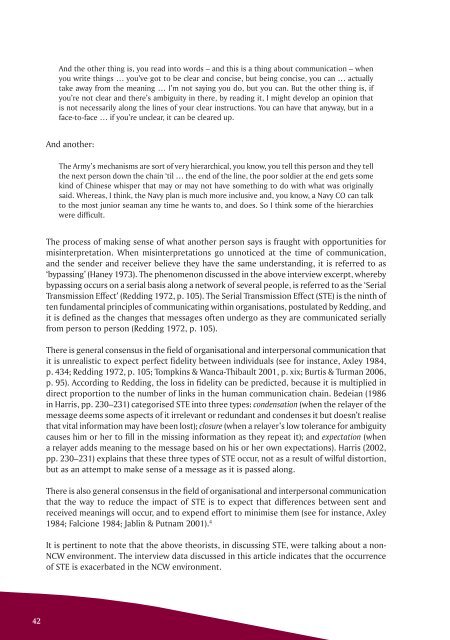ISSUE 176 : Jul/Aug - 2008 - Australian Defence Force Journal
ISSUE 176 : Jul/Aug - 2008 - Australian Defence Force Journal
ISSUE 176 : Jul/Aug - 2008 - Australian Defence Force Journal
Create successful ePaper yourself
Turn your PDF publications into a flip-book with our unique Google optimized e-Paper software.
And the other thing is, you read into words – and this is a thing about communication – when<br />
you write things … you’ve got to be clear and concise, but being concise, you can … actually<br />
take away from the meaning … I’m not saying you do, but you can. But the other thing is, if<br />
you’re not clear and there’s ambiguity in there, by reading it, I might develop an opinion that<br />
is not necessarily along the lines of your clear instructions. You can have that anyway, but in a<br />
face-to-face … if you’re unclear, it can be cleared up.<br />
And another:<br />
The Army’s mechanisms are sort of very hierarchical, you know, you tell this person and they tell<br />
the next person down the chain ‘til … the end of the line, the poor soldier at the end gets some<br />
kind of Chinese whisper that may or may not have something to do with what was originally<br />
said. Whereas, I think, the Navy plan is much more inclusive and, you know, a Navy CO can talk<br />
to the most junior seaman any time he wants to, and does. So I think some of the hierarchies<br />
were difficult.<br />
The process of making sense of what another person says is fraught with opportunities for<br />
misinterpretation. When misinterpretations go unnoticed at the time of communication,<br />
and the sender and receiver believe they have the same understanding, it is referred to as<br />
‘bypassing’ (Haney 1973). The phenomenon discussed in the above interview excerpt, whereby<br />
bypassing occurs on a serial basis along a network of several people, is referred to as the ‘Serial<br />
Transmission Effect’ (Redding 1972, p. 105). The Serial Transmission Effect (STE) is the ninth of<br />
ten fundamental principles of communicating within organisations, postulated by Redding, and<br />
it is defined as the changes that messages often undergo as they are communicated serially<br />
from person to person (Redding 1972, p. 105).<br />
There is general consensus in the field of organisational and interpersonal communication that<br />
it is unrealistic to expect perfect fidelity between individuals (see for instance, Axley 1984,<br />
p. 434; Redding 1972, p. 105; Tompkins & Wanca-Thibault 2001, p. xix; Burtis & Turman 2006,<br />
p. 95). According to Redding, the loss in fidelity can be predicted, because it is multiplied in<br />
direct proportion to the number of links in the human communication chain. Bedeian (1986<br />
in Harris, pp. 230–231) categorised STE into three types: condensation (when the relayer of the<br />
message deems some aspects of it irrelevant or redundant and condenses it but doesn’t realise<br />
that vital information may have been lost); closure (when a relayer’s low tolerance for ambiguity<br />
causes him or her to fill in the missing information as they repeat it); and expectation (when<br />
a relayer adds meaning to the message based on his or her own expectations). Harris (2002,<br />
pp. 230–231) explains that these three types of STE occur, not as a result of wilful distortion,<br />
but as an attempt to make sense of a message as it is passed along.<br />
There is also general consensus in the field of organisational and interpersonal communication<br />
that the way to reduce the impact of STE is to expect that differences between sent and<br />
received meanings will occur, and to expend effort to minimise them (see for instance, Axley<br />
1984; Falcione 1984; Jablin & Putnam 2001). 4<br />
It is pertinent to note that the above theorists, in discussing STE, were talking about a non-<br />
NCW environment. The interview data discussed in this article indicates that the occurrence<br />
of STE is exacerbated in the NCW environment.<br />
42

















